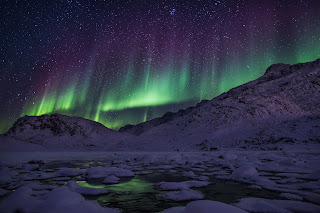CASE 461 - The history of Greenland
The history of Greenland is a history of life under extreme Arctic conditions: currently, an ice cap covers about 80 percent of the island, restricting human activity largely to the coasts. The first humans are thought to have arrived in Greenland around 2500 BC. Their descendants apparently died out and were succeeded by several other groups migrating from continental North America. There has been no evidence discovered that Greenland was known to Europeans until the 10th century, when Icelandic Vikings settled on its southwestern coast, which seems to have been uninhabited when they arrived. The ancestors of the Inuit Greenlanders who live there today appear to have migrated there later, around 1200 AD, from northwestern Greenland. While the Inuit survived in the icy world of the Little Ice Age, the early Norse settlements along the southwestern coast disappeared, leaving the Inuit as the only inhabitants of the island for several centuries. During this time, Denmark-Norway, apparently believing the Norse settlements had survived, continued to claim sovereignty over the island despite the lack of any contact between the Norse Greenlanders and their Scandinavian brethren. In 1721, aspiring to become a colonial power, Denmark-Norway sent a missionary expedition to Greenland with the stated aim of reinstating Christianity among descendants of the Norse Greenlanders who may have reverted to paganism. When the missionaries found no descendants of the Norse Greenlanders, they baptized the Inuit Greenlanders they found living there instead. Denmark-Norway then developed trading colonies along the coast and imposed a trade monopoly and other colonial privileges on the area.
During World War II, when Germany invaded Denmark, Greenlanders became socially and economically less connected to Denmark and more connected to the United States and Canada. After the war, Denmark resumed control of Greenland and in 1953 converted its status from colony to overseas amt (county). Although Greenland is still a part of the Kingdom of Denmark, it has enjoyed home rule since 1979. In 1985, the island decided to leave the European Union, which it had joined as a part of Denmark in 1973. From 1948 to 1950, the Greenland Commission studied the conditions on the island, seeking to address its isolation, unequal laws, and economic stagnation. In the end, the Royal Greenland Trading Department's monopolies were finally removed. In 1953, Greenland was raised from the status of colony to that of an autonomous province or constituent country of the Danish Realm. Despite its small population of 50000 to 55000 people, it was provided nominal representation in the Danish Folketing.
Greenland home rule
Greenland's minimal representation in the Folketing meant that despite 70.3% of Greenlanders rejecting entry into the European Common Market (EEC), it was pulled in along with Denmark in 1973. Fears that the customs union would allow foreign firms to compete and overfish its waters were quickly realized and the local parties began to push strongly for increased autonomy. The Folketing approved devolution in 1978 and the next year enacted home rule under a local Landsting. On 23 February 1982, a bare majority (53%) of Greenland's population voted to leave the EEC, a process which lasted until 1985. Greenland Home Rule has become increasingly Greenlandized, rejecting Danish and avoiding regional dialects to standardize the country under the language and culture of the Kalaallit (West Greenland Inuit). The capital Godthåb was renamed Nuuk in 1979; a local flag was adopted in 1985; the Danish KGH became the locally administered Kalaallit Niuerfiat (now KNI A/S) in 1986. Following a successful referendum on self-government in 2008, the local parliament's powers were expanded and Danish was removed as an official language in 2009.
International relations are now largely, but not entirely, also left to the discretion of the home rule government. After leaving the EEC, Greenland signed a special treaty with it, granting it special access to the market as a constituent country of Denmark, which remains a member. Greenland is also a member of several small organizations along with Iceland, the Faroes, and the Inuit populations of Canada and Russia. It was one of the founders of the environmental Arctic Council in 1996. The US military bases on the island remain a major issue, with some politicians pushing for renegotiation of the 1951 US–Denmark treaty by the Home Rule government. The 1999–2003 Commission on Self-Governance even proposed that Greenland should aim at Thule Air Base's removal from American authority and operation under the aegis of the United Nations.[




No comments:
Post a Comment